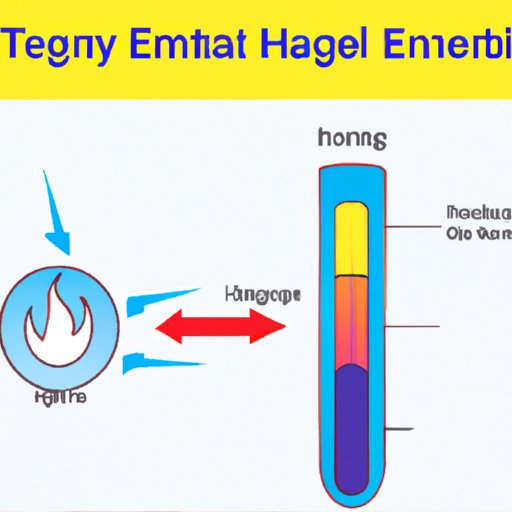Introduction
Thermal energy is a form of energy associated with the motion of molecules and atoms. It is a type of energy that is produced by the vibration and movement of particles in matter. Thermal energy is also known as heat energy, and is used in many scientific applications, from cooking food to powering engines. In this article, we will explore the basics of thermal energy in science, examine the role of heat and temperature in thermal energy, investigate the different forms of thermal energy, and analyze the effects of thermal energy on matter.
Exploring the Basics of Thermal Energy in Science
To understand thermal energy, it’s important to first define what it is. According to the National Renewable Energy Laboratory (NREL), thermal energy is “the energy contained in the motion of particles or molecules in a substance.” When particles are moving, they have energy, and this energy is called thermal energy. As the particles move faster, the thermal energy increases. This energy can be transferred from one object to another and can even be converted into other forms of energy.

Examining the Role of Heat and Temperature in Thermal Energy
Heat and temperature are two key concepts when it comes to understanding thermal energy. Heat is the transfer of thermal energy from one object to another, while temperature is a measure of how hot or cold something is. Heat is transferred through matter in three ways: conduction, convection, and radiation. Conduction occurs when two objects that are in contact with each other exchange thermal energy. Convection is the transfer of thermal energy through a liquid or gas, while radiation is the transfer of thermal energy through electromagnetic waves. All these processes involve the transfer of thermal energy.
When it comes to measuring heat and temperature, there are several units of measurement. The most commonly used unit is the Celsius scale, which measures temperature in degrees Celsius (°C). Another common unit of measurement is the Kelvin (K) scale, which measures temperature in Kelvins. Heat is measured in joules (J). One joule is the amount of energy needed to raise the temperature of one gram of water by one degree Celsius.

Investigating the Different Forms of Thermal Energy
Thermal energy can take many forms, including kinetic energy, potential energy, chemical energy, and electrical energy. Kinetic energy is the energy of motion and is produced when particles move. Potential energy is the energy stored in an object due to its position or configuration. Chemical energy is the energy stored in the bonds between atoms, while electrical energy is the energy created by the flow of electrons. All these forms of energy can be converted into thermal energy.

Analyzing the Effects of Thermal Energy on Matter
Thermal energy has a number of effects on matter. For example, when thermal energy is applied to matter, it causes the particles to vibrate more rapidly, increasing the temperature. This can cause physical changes to the matter, such as melting, boiling, or evaporating. Thermal energy can also cause chemical reactions to occur, as well as changes in the properties of the matter, such as its density, viscosity, and thermal conductivity.
Thermal energy can also have an impact on the environment. For instance, when fossil fuels are burned, they release large amounts of thermal energy into the atmosphere, which can lead to global warming. In addition, the burning of fossil fuels releases pollutants into the air, which can cause air pollution.
Conclusion
In conclusion, thermal energy is a form of energy associated with the motion of molecules and atoms. It is produced by the vibration and movement of particles in matter and can be converted into other forms of energy. Heat and temperature are two key concepts related to thermal energy, and thermal energy can take many forms, including kinetic energy, potential energy, chemical energy, and electrical energy. Thermal energy has a number of effects on matter, such as causing physical changes and chemical reactions, and it can also have an impact on the environment.
This article has explored the concept of thermal energy in science. Further research should focus on examining the relationship between thermal energy and other forms of energy, as well as investigating the various applications of thermal energy in everyday life.
(Note: Is this article not meeting your expectations? Do you have knowledge or insights to share? Unlock new opportunities and expand your reach by joining our authors team. Click Registration to join us and share your expertise with our readers.)
